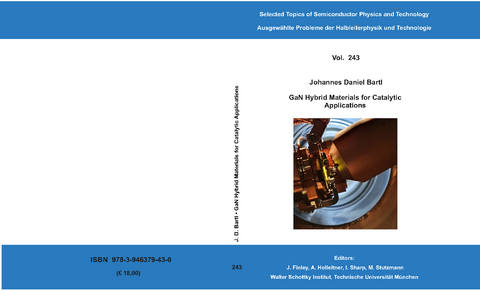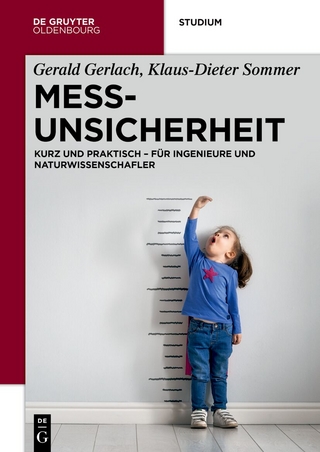GaN Hybrid Materials for Catalytic Applications
Seiten
2022
Verein zur Förderung des Walter Schottky Instituts der Technischen Universität München (Verlag)
978-3-946379-43-0 (ISBN)
Verein zur Förderung des Walter Schottky Instituts der Technischen Universität München (Verlag)
978-3-946379-43-0 (ISBN)
- Titel nicht im Sortiment
- Artikel merken
In this work integrated hybrid (electro-)photocatalysts combining molecular transition metal complexes and active semiconducting substrates were developed and investigated for their capability to reduce carbon dioxide (CO2). Due to a favorable band gap, band alignment, and optoelectronic properties gallium nitride (GaN) was used as an active support to accommodate different rhenium (Re)(I) bipyridine carbonyl complexes as model (photo )electrocatalysts widely known for a high CO2 conversion efficiency and product selectivity. The catalytic reactivity and stability could be significantly enhanced by systematically eliminating drawbacks tied to the molecular constituents and by exploiting synergies between the two materials.
To this end, flexible and reliable surface immobilization strategies were developed and investigated to covalently attach differently modified (Re)(I) bipyridine carbonyl complexes on planar GaN substrates. Self-assembled monolayers of phosphonic acids (SAMPs) were used as anchor interfaces due to high thermal and hydrolytic stability. Attributed to varying degrees of oxynitride species present in the respective surface oxides, polar (c-plane) and nonpolar (m-plane) GaN exhibit a significantly different affinity toward phosphonic acid (PA) surface chemistry. A strategy relying on a remote oxygen plasma (ROP) oxidation process was used to convert the m-plane’s surface oxide into a PA chemistry-compatible variant with sub-nanometer precision. Concurrently, the ROP process can be used to passivate the GaN surface, which can be tuned via the oxide layer thickness.
The apparent differences of the plane-specific surface chemistry prompted the implementation of a grafting protocol independent of the substrate’s surface properties. Referred to as modular surface assembly (MSA), the approach was developed and optimized on silicon (Si) (100) due to a similar PA surface chemistry compared to m-plane GaN and subsequently transferred to GaN as well as other materials such as diamond. Atomic layer deposition (ALD) was utilized to grow ultrathin (3 nm down to a single monolayer (ML)), amorphous, pin-hole free alumina (AlOx) layers acting as protective coatings for the active support and as activation layers for PA chemistry. The surface chemistry is significantly altered, enabling the reaction with PAs under ambient condition via simple immersion protocols. Furthermore, interfacial charge transfer via tunneling is possible, obviating the necessity of a sacrificial electron donor for the Re complex-mediated CO2 reduction. In addition, these ultrathin AlOx dielectrics effectively reduce the density of interface states, protect against photocorrosion, and are optically transparent, therefore, demonstrating potential for local gating and carrier selective contacts in Si solar cells. Following this approach, highly selective and stable target functionalities can be introduced to the underlying substrate, allowing attachment of the molecular (photo-)electrocatalysts via ‘click-chemistry’ with sub-nanometer precision. The precisely structured molecular ensembles exhibit strong intermolecular vibrational and electronic coupling, allowing the investigation of electron delocalization between individual, surface-immobilized molecular complexes. Due to the modular character of the developed surface functionalization route, individual components, such as substrate, PA anchor, coupling agent, and molecular catalyst can be flexibly exchanged and tuned according to the demands of the photo- or electrocatalytic conversion reaction.
Subsequently, the properties of the hybrid functional interfaces were investigated at the AlOx ML limit on GaN. To this end, the previously established, oxidant-free plasma-assisted atomic layer deposition (PA-ALD) process, was transferred to c-plane, Ga-polar GaN, resulting in the formation of an ultimately thin (~ 3 Å), yet continuous, AlOx ML. Similar to Si, the surface chemistry of GaN is significantly altered, allowing PA grafting with increased yields and simultaneously tailoring the surface energetics with sub-nanometer precision. In particular, a major challenge of traditional ALD could be addressed by eliminating the prospect of island formation during the initial growth phase, thus, providing an efficient approach to fabricate precise heterostructures with an unprecedented level of functional control over the semiconductor surface. By slight adjustments of the PA-ALD process parameters, in particular the hydrogen plasma power, the oxide interconversion mechanism opened additional pathways to control interfacial charge and mass transport as well as surface passivation and contact fabrication.
Finally, the (photo-)electrochemical properties of different Re(I) bipyridine carbonyl complex/GaN hybrid materials were investigated with a strong focus on the electron supply through the active GaN support. Due to catalyst loadings at the ML regime, an electrochemical (EC) approach, compatible with nanostructured surfaces, was implemented to elucidate their catalytic capacity. In particular, the effect of different coupling agents and coupling schemes were investigated and their influence on the EC and photocatalytic (PC) CO2 conversion capabilities was quantitatively assessed. The electron donating/withdrawing effect of the coupling agents can be used to precisely tailor the EC CO2 reduction onset potential, however, does not strictly correlate with their PC performance. As a proof of concept, light-assisted EC CO2 reduction could be demonstrated by a Re(I) bipyridine carbonyl complex-modified, AlOx (1 nm)-coated, planar GaN electrode. The hybrid catalyst exhibits a notable decrease of the Re complex-mediated CO2 reduction onset potential of ~ 0.6 V (-0.61 V vs. Ag/AgCl(pseudo)), which is attributed to a decrease of the EC LUMO relative to the unbound counterpart. Faradaic efficiency of ~ 45 % (for CO) could be achieved. Concurrently, the immobilization on the active GaN support provides significant protection against photo-induced degradation of the molecular constituents of the hybrid catalyst for several days of continuous irradiation.
To this end, flexible and reliable surface immobilization strategies were developed and investigated to covalently attach differently modified (Re)(I) bipyridine carbonyl complexes on planar GaN substrates. Self-assembled monolayers of phosphonic acids (SAMPs) were used as anchor interfaces due to high thermal and hydrolytic stability. Attributed to varying degrees of oxynitride species present in the respective surface oxides, polar (c-plane) and nonpolar (m-plane) GaN exhibit a significantly different affinity toward phosphonic acid (PA) surface chemistry. A strategy relying on a remote oxygen plasma (ROP) oxidation process was used to convert the m-plane’s surface oxide into a PA chemistry-compatible variant with sub-nanometer precision. Concurrently, the ROP process can be used to passivate the GaN surface, which can be tuned via the oxide layer thickness.
The apparent differences of the plane-specific surface chemistry prompted the implementation of a grafting protocol independent of the substrate’s surface properties. Referred to as modular surface assembly (MSA), the approach was developed and optimized on silicon (Si) (100) due to a similar PA surface chemistry compared to m-plane GaN and subsequently transferred to GaN as well as other materials such as diamond. Atomic layer deposition (ALD) was utilized to grow ultrathin (3 nm down to a single monolayer (ML)), amorphous, pin-hole free alumina (AlOx) layers acting as protective coatings for the active support and as activation layers for PA chemistry. The surface chemistry is significantly altered, enabling the reaction with PAs under ambient condition via simple immersion protocols. Furthermore, interfacial charge transfer via tunneling is possible, obviating the necessity of a sacrificial electron donor for the Re complex-mediated CO2 reduction. In addition, these ultrathin AlOx dielectrics effectively reduce the density of interface states, protect against photocorrosion, and are optically transparent, therefore, demonstrating potential for local gating and carrier selective contacts in Si solar cells. Following this approach, highly selective and stable target functionalities can be introduced to the underlying substrate, allowing attachment of the molecular (photo-)electrocatalysts via ‘click-chemistry’ with sub-nanometer precision. The precisely structured molecular ensembles exhibit strong intermolecular vibrational and electronic coupling, allowing the investigation of electron delocalization between individual, surface-immobilized molecular complexes. Due to the modular character of the developed surface functionalization route, individual components, such as substrate, PA anchor, coupling agent, and molecular catalyst can be flexibly exchanged and tuned according to the demands of the photo- or electrocatalytic conversion reaction.
Subsequently, the properties of the hybrid functional interfaces were investigated at the AlOx ML limit on GaN. To this end, the previously established, oxidant-free plasma-assisted atomic layer deposition (PA-ALD) process, was transferred to c-plane, Ga-polar GaN, resulting in the formation of an ultimately thin (~ 3 Å), yet continuous, AlOx ML. Similar to Si, the surface chemistry of GaN is significantly altered, allowing PA grafting with increased yields and simultaneously tailoring the surface energetics with sub-nanometer precision. In particular, a major challenge of traditional ALD could be addressed by eliminating the prospect of island formation during the initial growth phase, thus, providing an efficient approach to fabricate precise heterostructures with an unprecedented level of functional control over the semiconductor surface. By slight adjustments of the PA-ALD process parameters, in particular the hydrogen plasma power, the oxide interconversion mechanism opened additional pathways to control interfacial charge and mass transport as well as surface passivation and contact fabrication.
Finally, the (photo-)electrochemical properties of different Re(I) bipyridine carbonyl complex/GaN hybrid materials were investigated with a strong focus on the electron supply through the active GaN support. Due to catalyst loadings at the ML regime, an electrochemical (EC) approach, compatible with nanostructured surfaces, was implemented to elucidate their catalytic capacity. In particular, the effect of different coupling agents and coupling schemes were investigated and their influence on the EC and photocatalytic (PC) CO2 conversion capabilities was quantitatively assessed. The electron donating/withdrawing effect of the coupling agents can be used to precisely tailor the EC CO2 reduction onset potential, however, does not strictly correlate with their PC performance. As a proof of concept, light-assisted EC CO2 reduction could be demonstrated by a Re(I) bipyridine carbonyl complex-modified, AlOx (1 nm)-coated, planar GaN electrode. The hybrid catalyst exhibits a notable decrease of the Re complex-mediated CO2 reduction onset potential of ~ 0.6 V (-0.61 V vs. Ag/AgCl(pseudo)), which is attributed to a decrease of the EC LUMO relative to the unbound counterpart. Faradaic efficiency of ~ 45 % (for CO) could be achieved. Concurrently, the immobilization on the active GaN support provides significant protection against photo-induced degradation of the molecular constituents of the hybrid catalyst for several days of continuous irradiation.
| Erscheinungsdatum | 01.07.2022 |
|---|---|
| Sprache | englisch |
| Maße | 150 x 210 mm |
| Themenwelt | Naturwissenschaften ► Physik / Astronomie |
| Schlagworte | catalysis • GaN • hybrid materials |
| ISBN-10 | 3-946379-43-5 / 3946379435 |
| ISBN-13 | 978-3-946379-43-0 / 9783946379430 |
| Zustand | Neuware |
| Haben Sie eine Frage zum Produkt? |
Mehr entdecken
aus dem Bereich
aus dem Bereich
von den Werkzeugen über Methoden zum TQM
Buch | Softcover (2024)
Springer Fachmedien (Verlag)
32,99 €
kurz und praktisch - für Ingenieure und Naturwissenschafler
Buch | Softcover (2024)
De Gruyter Oldenbourg (Verlag)
44,95 €




